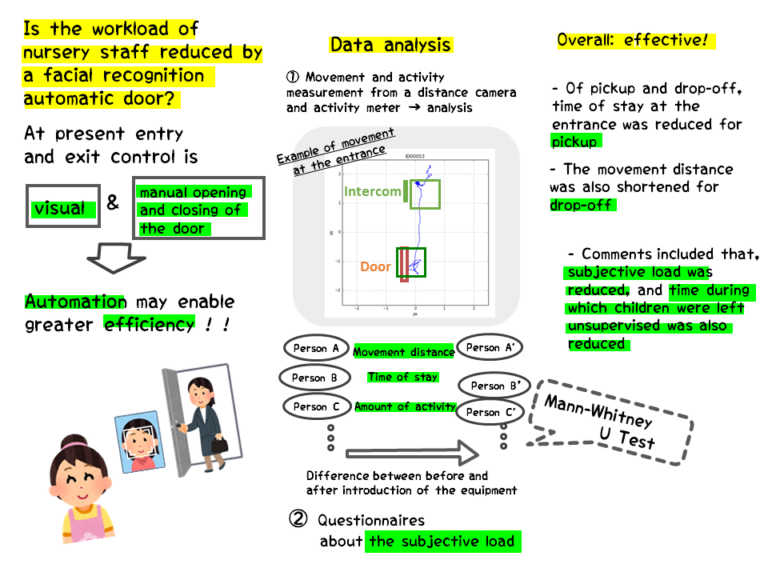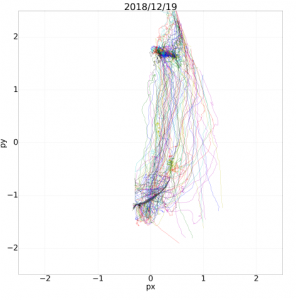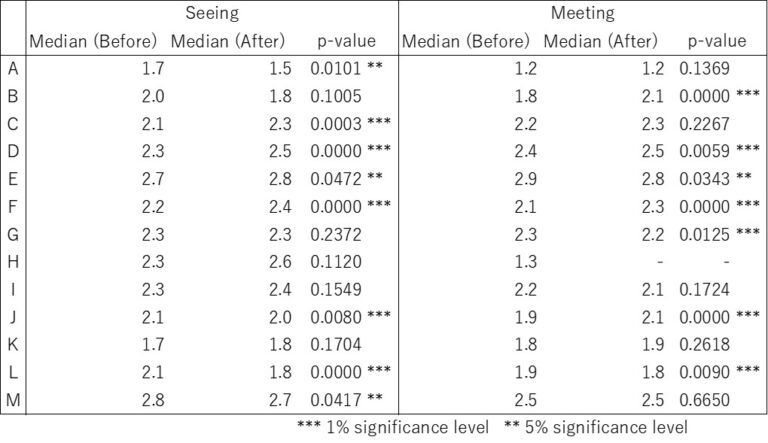Abstract

Issues and Background
- The employment rate of 25- to 44-year-old females is increasing, and as a result childcare waiting lists have become a social problem particularly in large cities
- The personnel turnover rate of nursery staff is about 10% (Ministry of Health, Labour and Welfare, 2015), and the main reasons are personal relationships, employment conditions, and workload (Poppins Corporation, 2011)
- From interviews at the applicable day-care center, the opinion “At present we answer the intercom by visually confirming faces and opening doors manually, but we would like the door to be opened automatically after automatic recognition by machine fingerprint recognition or facial recognition” has been offered
- There has been very little research in Japan focusing on the workload of nursery staff or parents in day-care centers, and none of this research has evaluated the workload of nursery staff from both quantitative and qualitative aspects.
Data
By introducing an automatic door that performs facial recognition at entrance intercoms, we examined whether the activity intensity, movement distance, and time of stay of nursery staff and time of stay of parents during pickup and drop-off are reduced, thereby relieving the load on nursery staff and parents.
| Day-care center under study | University of Tsukuba Yurinoki Day-Care Center |
| Equipment used | LIQUID KEY facial recognition entry and exit control system, Xtion (distance camera), and Active style Pro HJA-750C (activity meter) |
| Experiment period | October to December 2018 |
| Experimental method | Measurement of movement with distance camera, measurement of the activity intensity of nursery staff and parents, questionnaires |
| Subjects of experiment | Activity measurement: 13 regular nursery staff Registration of faces to facial recognition automatic door: 27 nursery staff and 87 parents Questionnaires: 17 persons associated with the day-care center and 45 parents |
Analysis
- Mann–Whitney U test of the movement distance and time of stay
A non-parametric Mann–Whitney U test was performed (Table 1) for the time of stay at the entrance and the movement distance and time of stay indoors, before and after installation of the facial recognition automatic door, using the distance camera data (Fig. 1: Example showing movement)
*The facial recognition system was installed below the existing intercom, so it is obvious that the movement distance at the entrance was unchanged as a result of the installation of the facial recognition automatic door, so this item was excluded from the test
– The time of stay at the entrance during pickup was reduced after installation of the door
– Indoors, the movement distance during drop-off was reduced after installation of the door compared with before installation, but on the other hand the time of stay during pickup was increased


- Mann-Whitney U Test of the activity intensity
The Mann-Whitney U Test was performed for activity intensity before and after installation of the facial recognition automatic door, using the activity meter data (Table 2: A to M indicate nursery staff)
– The number of nursery staff for whom the amount of activity was reduced after installation of the door during drop-off or pickup was 6 out of 13 nursery staff

- Questionnaires
– In the questionnaires after installation, all 16 nursery staff evaluated the facial recognition automatic door highly in terms of “workload (e.g., saves time and effort),” which was the most highly anticipated benefit of the facial recognition automatic door by the nursery staff
– It was found that the next issue was not just unlocking, but also to be able to check from anywhere within the center
– Among parents, the most highly evaluated point regarding installation of the facial recognition automatic door was also “workload (e.g., saves time and effort)”
– The percentage that replied that they “agreed” or “somewhat agreed’ with continuing the use of the facial recognition automatic door was 100% of nursery staff and 98% of the parents
Results
- The time of stay at the entrance during pickup was reduced
→ It is considered that this is because as a result of introduction of the facial recognition automatic door, entry is possible without waiting for the nursery staff to unlock the door - On the other hand, the time of stay indoors during pickup was increased
→ It is considered that this is due to re-checking on a tablet faces that were recognized, and responding to the arrival of unregistered parents - The movement distance indoors during drop-off was reduced
→ It is considered that this is because movement to the interior intercom every time the intercom rang was eliminated - For some nursery staff the activity intensity increased and for others it decreased
→ No difference according to age was seen, and further measurement is necessary to clarify the effect of the facial recognition automatic door - From the questionnaire results, it is considered that the load on both nursery staff and guardians was reduced
- Tasks for the future include registration of the faces of everyone in charge of pickup and drop-off, testing during normal times when there is no event, installation of facial recognition automatic doors at all the intercoms in the five locations within the center, measurement after sufficient time for familiarization, etc.
References
Ministry of Internal Affairs and Communications, “Labor Force Survey – Historical Data”
(Date last viewed February 2, 2018)
Ministry of Health, Labour and Welfare (2018), “Summary of the Status of Day-care Centers, Etc. (April 1, 2018)”
Prime Minister’s Office of Japan homepage
(Date last viewed December 1, 2018)
Ministry of Health, Labour and Welfare, “Survey of Social Welfare Institutions”
(Date last viewed February 2, 2018)
Ministry of Health, Labour and Welfare (2015), “Documents Relating to Nursery Staff”
ka/s.1_3.pdf
Poppins Corporation “Guidebook for Potential Nursery Staff”


